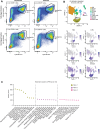Synovial macrophage diversity and activation of M-CSF signaling in post-traumatic osteoarthritis
- PMID: 39969512
- PMCID: PMC11839164
- DOI: 10.7554/eLife.93283
Synovial macrophage diversity and activation of M-CSF signaling in post-traumatic osteoarthritis
Abstract
Synovium is home to immune and stromal cell types that orchestrate inflammation following a joint injury; in particular, macrophages are central protagonists in this process. We sought to define the cellular and temporal dynamics of the synovial immune niche in a mouse model of post-traumatic osteoarthritis (PTOA), and to identify stromal-immune crosstalk mechanisms that coordinate macrophage function and phenotype. We induced PTOA in mice using a non-invasive tibial compression model of anterior cruciate ligament rupture (ACLR). Single-cell RNA-sequencing and flow cytometry were used to assess immune cell populations in healthy (Sham) and injured (7 and 28 days post-ACLR) synovium. Characterization of synovial macrophage polarization states was performed, alongside computational modeling of macrophage differentiation, as well as implicated transcriptional regulators and stromal-immune communication axes. Immune cell types are broadly represented in healthy synovium, but experience drastic expansion and speciation in PTOA, most notably in the macrophage portion. We identified several polarization states of macrophages in synovium following joint injury, underpinned by distinct transcriptomic signatures, and regulated in part by stromal-derived macrophage colony-stimulating factor signaling. The transcription factors Pu.1, Cebpα, Cebpβ, and Jun were predicted to control differentiation of systemically derived monocytes into pro-inflammatory synovial macrophages. In summary, we defined different synovial macrophage subpopulations present in healthy and injured mouse synovium. Nuanced characterization of the distinct functions, origins, and disease kinetics of macrophage subtypes in PTOA will be critical for targeting these highly versatile cells for therapeutic purposes.
Keywords: immunology; inflammation; joint injury; macrophages; mouse; osteoarthritis; single-cell RNA-seq; synovium.
© 2023, Knights et al.
Conflict of interest statement
AK, EF, OE, MS, CA, TM No competing interests declared
Figures


















Update of
-
Synovial macrophage diversity and activation of M-CSF signaling in post-traumatic osteoarthritis.bioRxiv [Preprint]. 2023 Oct 5:2023.10.03.559514. doi: 10.1101/2023.10.03.559514. bioRxiv. 2023. Update in: Elife. 2025 Feb 19;12:RP93283. doi: 10.7554/eLife.93283. PMID: 37873464 Free PMC article. Updated. Preprint.
References
-
- Aibar S, González-Blas CB, Moerman T, Huynh-Thu VA, Imrichova H, Hulselmans G, Rambow F, Marine J-C, Geurts P, Aerts J, van den Oord J, Atak ZK, Wouters J, Aerts S. SCENIC: single-cell regulatory network inference and clustering. Nature Methods. 2017;14:1083–1086. doi: 10.1038/nmeth.4463. - DOI - PMC - PubMed
-
- Alivernini S, MacDonald L, Elmesmari A, Finlay S, Tolusso B, Gigante MR, Petricca L, Di Mario C, Bui L, Perniola S, Attar M, Gessi M, Fedele AL, Chilaka S, Somma D, Sansom SN, Filer A, McSharry C, Millar NL, Kirschner K, Nerviani A, Lewis MJ, Pitzalis C, Clark AR, Ferraccioli G, Udalova I, Buckley CD, Gremese E, McInnes IB, Otto TD, Kurowska-Stolarska M. Distinct synovial tissue macrophage subsets regulate inflammation and remission in rheumatoid arthritis. Nature Medicine. 2020;26:1295–1306. doi: 10.1038/s41591-020-0939-8. - DOI - PubMed
-
- Belkina AC, Ciccolella CO, Anno R, Halpert R, Spidlen J, Snyder-Cappione JE. Automated optimized parameters for T-distributed stochastic neighbor embedding improve visualization and analysis of large datasets. Nature Communications. 2019;10:5415. doi: 10.1038/s41467-019-13055-y. - DOI - PMC - PubMed
MeSH terms
Substances
Associated data
- Actions
- Actions
- Actions
- Actions
- Actions
Grants and funding
- K99 AR081894/AR/NIAMS NIH HHS/United States
- R01 AR080035/AR/NIAMS NIH HHS/United States
- R21 AR076487/AR/NIAMS NIH HHS/United States
- R21 AR082016/AR/NIAMS NIH HHS/United States
- K99AR081894/AR/NIAMS NIH HHS/United States
- UC2 AR082186/AR/NIAMS NIH HHS/United States
- R21AR082016/NH/NIH HHS/United States
- HT94252310327/Congressionally Directed Medical Research Programs
- R21 AR080502/AR/NIAMS NIH HHS/United States
- R21AR076487/AR/NIAMS NIH HHS/United States
- R21AR080502/NH/NIH HHS/United States
- R01AR080035/AR/NIAMS NIH HHS/United States
- Catalyst Award/Ralph and Marian Falk Medical Research Trust
LinkOut - more resources
Full Text Sources
Medical
Research Materials
Miscellaneous

